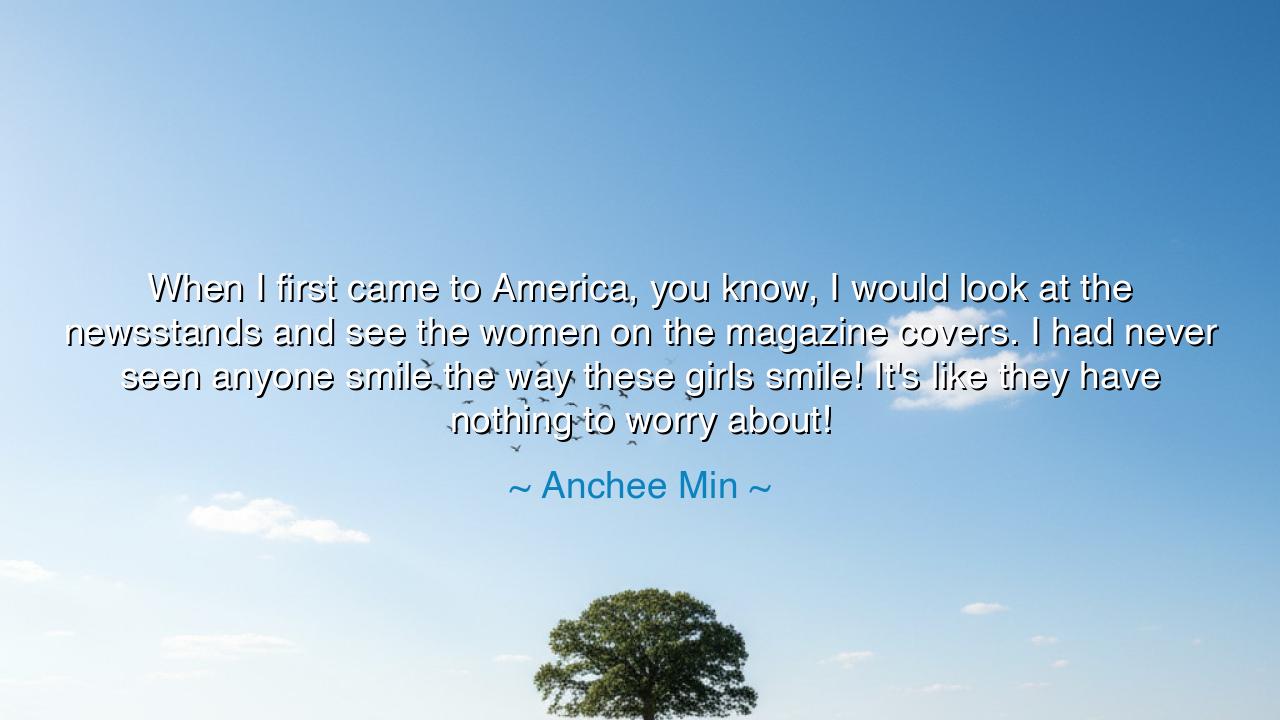
When I first came to America, you know, I would look at the
When I first came to America, you know, I would look at the newsstands and see the women on the magazine covers. I had never seen anyone smile the way these girls smile! It's like they have nothing to worry about!






Hear the words of Anchee Min: “When I first came to America, you know, I would look at the newsstands and see the women on the magazine covers. I had never seen anyone smile the way these girls smile! It’s like they have nothing to worry about!” In this reflection lies a vision of two worlds—the world of restraint and burden, and the world of abundance and ease. The smile, simple and effortless on the glossy pages, became for Min a symbol of a freedom she had not known before. It was not merely a curve of the lips, but a revelation of a culture where joy could be displayed without fear, and where the image of life itself seemed untroubled, radiant, unbound.
For those who come from lands where survival outweighs expression, the smile can appear almost otherworldly. To smile so openly, as if free from care, is to reveal a spirit unchained by constant vigilance or scarcity. In ancient times, the peasants who toiled under heavy tax and ceaseless war could scarcely imagine the feasts and laughter of the ruling courts. So it was for Anchee Min, raised under the shadow of hardship, when she first beheld the painted smiles of American magazines. They did not speak to her of fashion alone—they whispered of a different kind of existence, one where worry seemed distant, where the weight of survival had given way to leisure and the luxury of joy.
Yet we must be cautious, for even the brightest image may hide shadows behind it. Those smiles on the covers, perfect and unblemished, are not always the pure reflection of reality. They are symbols—crafted, curated, designed to sell not only beauty but the dream of freedom from worry. History tells us this truth: in Rome, emperors staged grand spectacles, filling the arenas with games and laughter, not only to entertain the people but to veil their own troubles and the unrest simmering beneath the empire’s surface. Smiles may dazzle, but they do not always reveal the whole of life.
And yet, there is power even in the symbol. For when one sees a smile, even if staged, something within is awakened—a longing, a reminder that life is meant for joy as well as for labor. Consider the story of immigrants arriving at Ellis Island in the early 20th century. They stepped ashore weary, hungry, carrying little. But in the faces of those who greeted them with smiles, they found a vision of possibility. The smile said, “Here, perhaps, you may live without the same burdens. Here, perhaps, you may find rest.” The power of a smile is that it can give courage even when circumstances remain unchanged.
Anchee Min’s words also uncover a deeper contrast: the difference between cultures of silence and cultures of expression. In many lands, to smile without reason is seen as foolish or even dangerous, for it may signal vulnerability. But in America, the smile is a language in itself, a signal of openness, invitation, and ease. What she witnessed on those magazine covers was not only beauty—it was the outward sign of a people who had learned, or at least imagined, how to carry themselves as though worry did not rule them. Whether true or illusion, it was a striking difference from her own past, and it marked her forever.
The lesson for us, then, is twofold. First, let us not be deceived into thinking that smiles on glossy pages reveal the full truth of life. Behind them, struggles often remain, unseen but real. Yet second, let us not dismiss the power of the smile, for it has the ability to inspire, to soften, to awaken hope in those who look upon it. Even if born of artifice, it can point toward a reality worth striving for—a life where joy outweighs despair, where burdens do not silence laughter.
So let us live this wisdom: smile, not because your life is without worry, but because in smiling, you declare that worry does not own you. Offer your smile as a gift to others, a light for the weary traveler, a signal that life is not only hardship but also beauty. And when you see the smiles of others—whether on magazine covers or in the faces of strangers—do not envy them blindly, but let them remind you that joy is possible, even in a world of burdens. For the smile is more than expression; it is defiance, it is hope, it is the ancient language of the heart that says: life is still worth living.






AAdministratorAdministrator
Welcome, honored guests. Please leave a comment, we will respond soon